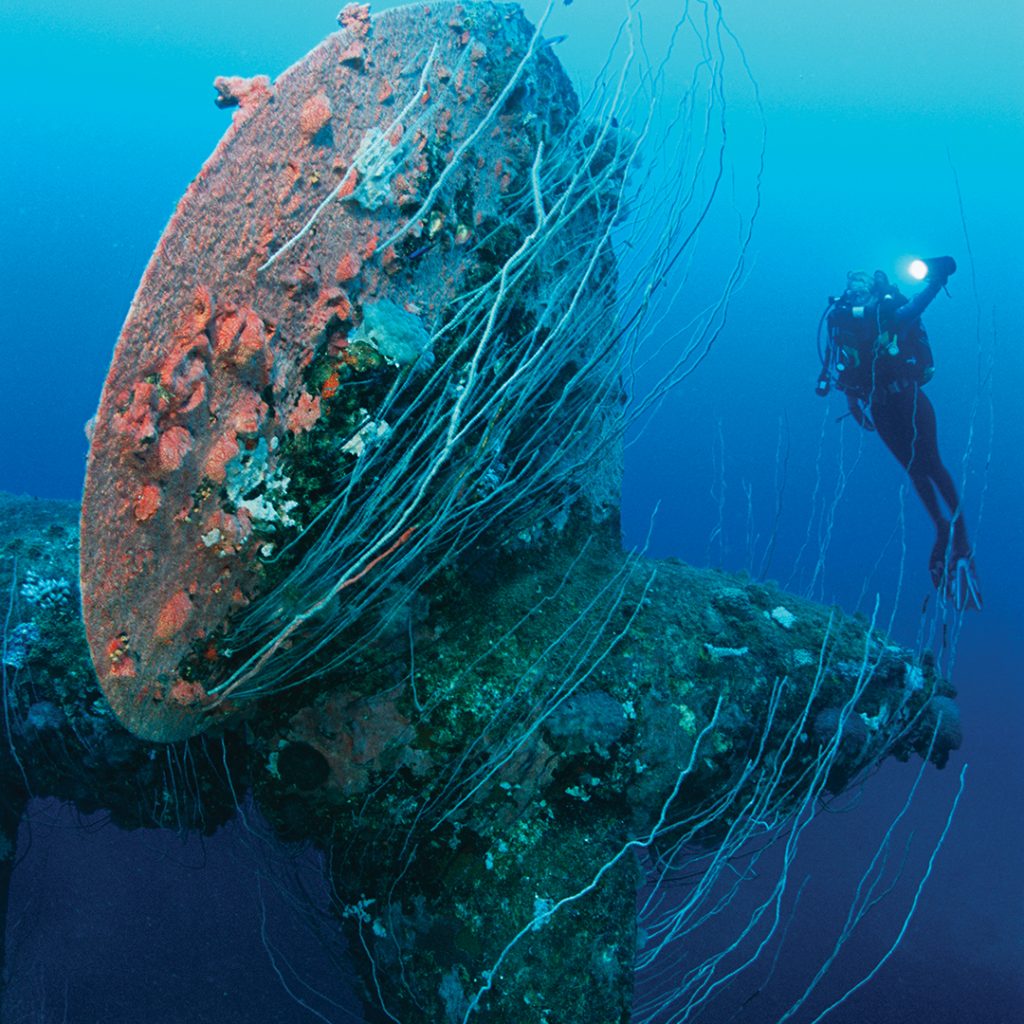There’s something liberating about the depths of the world’s oceans. From perilous shipwrecks to glowing coral reefs, avid divers can explore parts of the Earth that were submerged both recently and thousands of years ago. Winding limestone structures, polychromatic colors, underwater volcanoes all offer glimpses of the world beneath the surface. Atlantis may only be legend, but these once-in-a-lifetime attractions are a close second. Check out this list of the best places on Earth to dive for your next nautical adventure. This is true Dream Diving!
Yucatán, Mexico
The peninsula is home to about 6,000 cenotes (or caves) that are perfect for underwater exploration. There are a variety of dive sites to choose from, whether you’re in search of reefs, wrecks or ruins. Most of these cenotes leave pools of magnificent blue water at their peaks, allowing you to enjoy floating and cliff diving. Yucatán attracts divers from all over the world due to its tropical climate and warm waters. Glide through the translucent waters that were once revered and essential to life for ancient Mayans. Sunlight reflecting off of overhanging limestone stalagmites, air pockets and submerged tunnels will make anyone feel like Captain Nemo. Here, you can channel your inner explorer and witness some of the most unique underwater landscapes in the world.

Red Sea, Egypt
Like the ancient treasures found in Cairo, diving in the Red Sea is otherworldly. With the water rarely dropping below 71 degrees Fahrenheit, it is a kaleidoscope of coral reefs and tropical fish. Embarking from isolated starting points like The Brothers Islands, Daedalus or Rocky is ideal for those who prefer to explore away from crowds. Home to over 1,100 species of fish, you’ll be greeted by a numerous variety of manta rays, dolphins and sharks, including the whale shark and the endangered scalloped hammerhead shark. Divers can also explore famous shipwrecks that date back to the Second World War like the SS Thistlegorm which was a merchant ship that over time split open, allowing visitors to see objects inside such as motorbikes, weapons and armored cars.

Aliwal Shoal, South Africa
This rocky reef is the remains of an ancient sand dune that is located approximately three miles off the coast of KwaZulu-Natal, South Africa. Here, divers can be sure to find a little bit of everything from colorful coral reefs to schools of fish and shipwrecks. Inside Edge is perfect for seeing octopuses, cuttlefish, scorpionfish, eels and anemones. Between May and August, divers can witness the yearly sardine run. This phenomena happens when sardines migrate for the season, they travel in a tunnel of current that flows at around 21 degrees celsius. They are unable to swim outside of this current making them easy prey for predators that wander over to feed. Find the wreckages of the 1884 SS Nebo and the 1974 bulk carrier, Produce, near the main dive site.

Bikini Atoll, Marshall Islands
This next spot is exclusively for the daredevil adventurer. Between 1948 and 1956 the U.S. used the Marshall Islands, located in the central Pacific Ocean between Hawaii and the Philippines, for atomic bomb testing. The area is still considered more radioactive than Chernobyl. Although the area was closed for tourists in 2008, you can still set up a dive experience with Bikini Atoll Divers. A dive here will grant you access to the ships that were used for and wrecked by nuclear bomb testing. The archipelago became a designated UNESCO World Heritage Site in 2010.

Galapagos, Ecuador
The archipelago was made famous by Charles Darwin’s recordings of the pristine and diverse plant and animal life. Visitors will behold the sight of marvelous hundred-year-old tortoises, froclicking sea lions, blue-footed boobies, lava lizards and even the waved albatross before even stepping into its astounding blue waters. Beneath the ocean, divers will be glad to find there is almost perfect visibility, meaning you’ll be able to see all of the ocean life relatively clearly. Make sure to visit El Arco, or Darwin’s Arch, where it is not uncommon to see schools of sharks and rays that are unique to the region.

Great Blue Hole, Belize
The Great Blue Hole is a giant marine sinkhole and a hotspot for divers and explorers alike. The sunken caves are made up of limestone structures that formed thousands of years ago before sea levels rose to what they are today. Similar to cenotes, divers can explore the depths of the sunken cave and meet midnight parrotfish and Caribbean reef sharks. The site was made famous in the ‘70s by conservationist, filmmaker and explorer Jacques Cousteau who brought his ship, the Calypso, to track its depths and later named it one of the top five dive sites on the planet. In 2012, the Discovery Channel called the Great Blue Hole one of “The 10 Most Amazing Places on Earth.”

Kittiwake Shipwreck ASR-13, Grand Cayman
The Cayman Islands are well-known for their coral reefs and bioluminescent creatures. In 2009, the Cayman Islands Tourism Association was given the greenlight to use the USS Kittiwake as an artificial coral reef. Prior to its sinking, it needed to go through the proper procedures to ensure all hazardous materials (such as lead paint) were removed from the ship. In preparation for its new use as a divers’ playground, the ship was cut with holes fit for easier swim-throughs and some floors, doors and hatches were removed as well. Today, it is a very popular dive site designed to complement and benefit its environment.

Ari Atoll, Maldives
The archipelago of the Maldives is comprised of 105 islands. Its pristine waters and variety of ocean depths make this a perfect area for divers of all skill levels. Many travel to Ari Atoll to see the enchanting cyclone feeding that takes place between the months of May to October. Around 200 manta rays create a huge spiral that allows them to easily feed on plankton that are found in the area in the spring, summer and fall. Oftentimes, local sharks join in on the feeding, making it a spectacular experience for any diver. Strong currents can prove dangerous for beginners so make sure to consult the diving guides before venturing out on your own.

Rangiroa, French Polynesia
Swim amongst the rays, sharks and colorful fish that call this region home. There are a few dive companies to choose from that offer a variety of packages allowing plenty of time to explore the wonders and wildlife that lie beneath the ocean in Rangiroa. Atolls are essentially volcanoes that were fully submerged millions of years ago as sea levels rose. The only part that we can see from above sea level is the summit of the volcano where wildlife like coral reefs flourish. The lagoon forms in the caldera of the volcano. Atolls are remnants of Earth’s prehistoric periods that can still be experienced as sites with a great deal of biodiversity.

Thingvellir National Park, Iceland
Most people visit Iceland for bucket list views of the northern lights, to swim the natural volcanic springs, or even to drive around the entire country soaking in nature. Yet another activity to partake in when visiting Iceland is to explore Thingvellir National Park. Here, divers can witness the North American and Eurasian tectonic plates that divide the two continents and continue to expand about an inch per year. The crystal clear water is filtered through lava fields making it safe to drink and allows for visibility exceeding 300 feet. Although there’s no license requirement, there is a certain amount of experience divers must have before plunging into this adventure.







